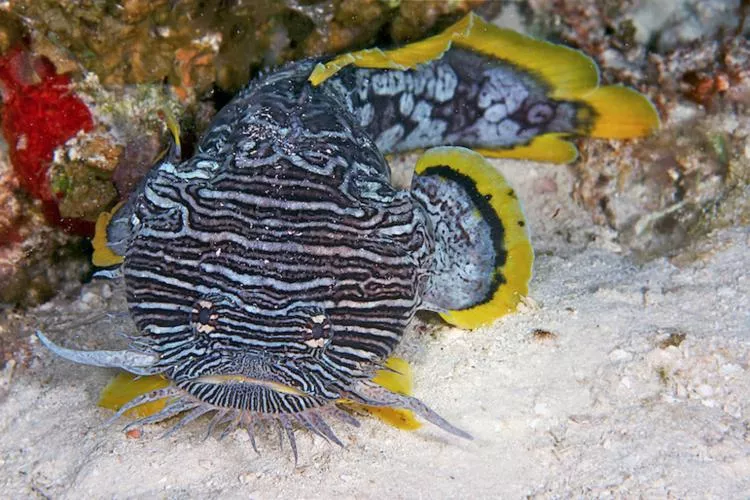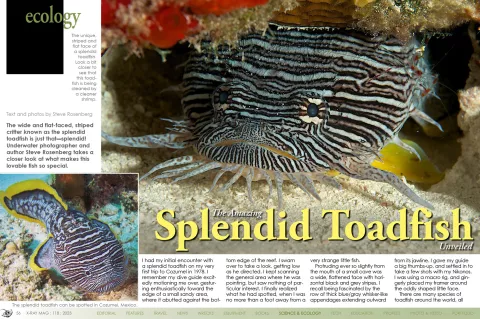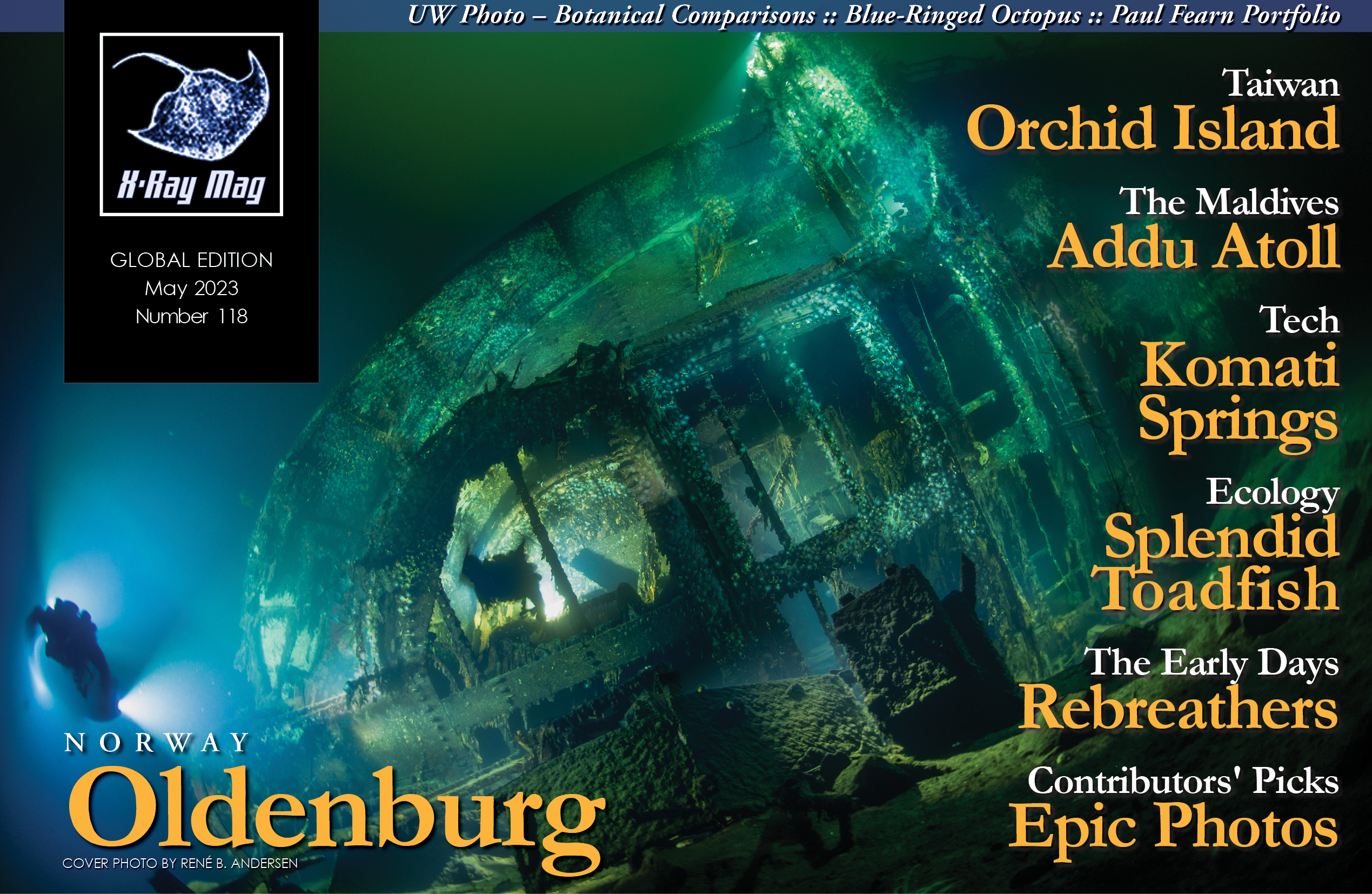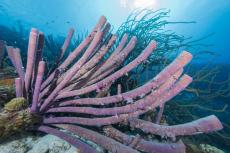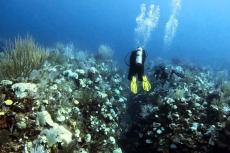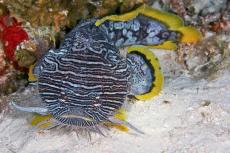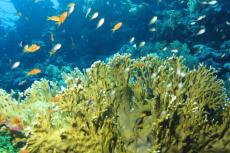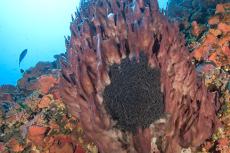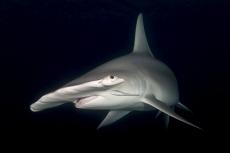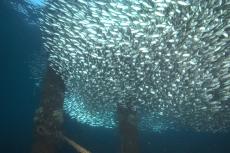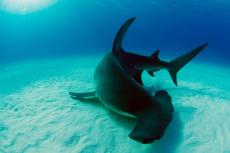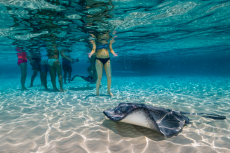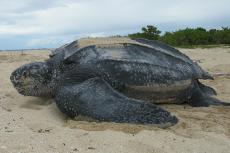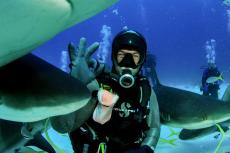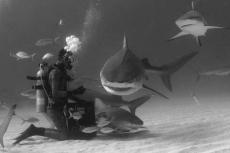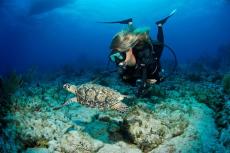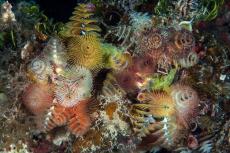The wide and flat-faced, striped critter known as the splendid toadfish is just that—splendid! Underwater photographer and author Steve Rosenberg takes a closer look at what makes this lovable fish so special.
Contributed by
I had my initial encounter with a splendid toadfish on my very first trip to Cozumel in 1978. I remember my dive guide excitedly motioning me over, gesturing enthusiastically toward the edge of a small sandy area, where it abutted against the bottom edge of the reef. I swam over to take a look, getting low as he directed. I kept scanning the general area where he was pointing, but saw nothing of particular interest. I finally realized what he had spotted, when I was no more than a foot away from a very strange little fish.
Protruding ever so slightly from the mouth of a small cave was a wide, flattened face with horizontal black and grey stripes. I recall being fascinated by the row of thick blue/gray whisker-like appendages extending outward from its jawline. I gave my guide a big thumbs-up, and settled in to take a few shots with my Nikonos. I was using a macro rig, and gingerly placed my framer around the oddly shaped little face.
There are many species of toadfish around the world, all of which have solid colors of brown, olive and gray, allowing them to easily blend in with their surroundings. Toadfish are ambush predators, and they normally use their drab coloration as camouflage, which would help them hide from potential prey, even when they are out in the open.
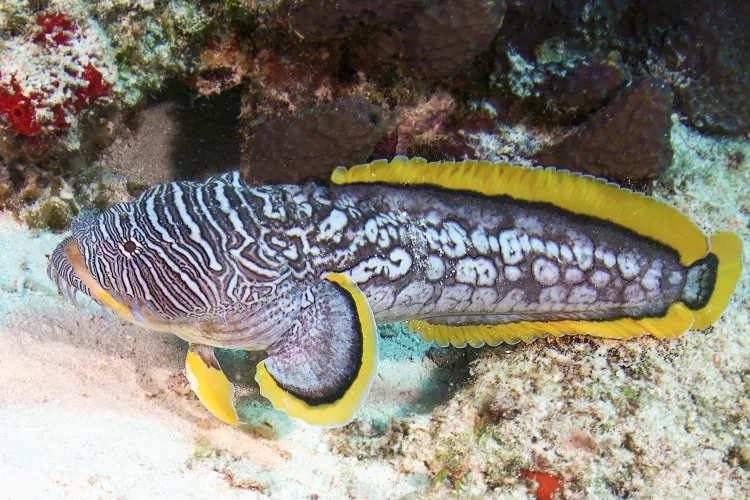
Characteristics
I had a difficult time imagining that the splendid toadfish would be capable of hiding from anything. Cozumel’s resident toadfish is called a “splendid” toadfish for a reason. It has a rather gaudy color pattern. Its face and upper body has horizontal stripes of black, blue and grey, while the long, rear body area has larger, blotchy-black to charcoal or blue markings. This species of toadfish has a total of eight fins: two dorsal fins, two pectoral fins, two pelvic fins, a caudal fin and an anal fin—all of which are bordered with a strip of bright yellow.
An adult splendid toadfish can grow to be about 10 inches (25cm) long, with a large head and a long body that tapers down to a point. Its relatively good size and flamboyant colors would certainly make it eye-catching… except for the fact that this fish lives mostly sequestered in small, protected dens, with only its head visible. One of the most distinctive features of the splendid toadfish is its wide compressed head and jaw, edged with blue fleshy whisker-like appendages called “barbels.”
Toadfishes have very powerful jaws. It would probably be advisable to be careful not to get your fingers too close to their mouths. Toadfish may try to bite as a defensive action. Their strong jaws are lined with small, sharp teeth. They have deep-set eyes that are located on the top of their heads, and positioned to look upwards. As with many species that live close to the sand, they do not need forward vision.
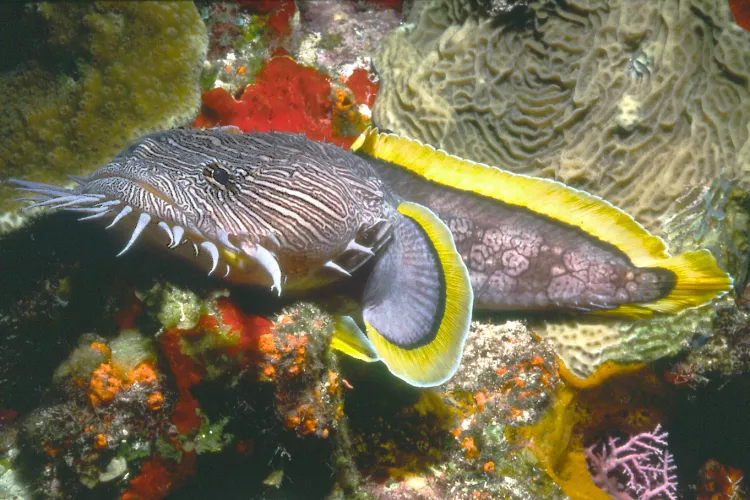
Distribution
The splendid toadfish was thought by many to be strictly endemic to Cozumel, a small island located off the coast of Mexico’s Yucatán peninsula. However, over the course of the last thirty years, it has been spotted in various nearby locations. I have seen and photographed them along the shoreline in Honduras and in the shallows off the coast of the Yucatán near Playa Del Carmen. They have also recently been encountered around the island of Isla Mujeres, located to the north of Cozumel off Cancun, and on a reef in Belize.
Behavior
As an ambush predator, this toadfish hides within small crevasses and cracks along Cozumel’s shallow coral reefs with just the forward end of its face peeking out, making it somewhat difficult to spot. They are not called toadfish because they look like toads. The name originates from the fact that they produce a repetitive, audible croak that is associated with mating behavior.
If you hear their croak during a dive, start looking around the edges of the flat, sandy areas adjacent to the lower edges of the reef. Scan the edges of the sand flats where they border the bottom of the reef slopes, specifically looking for small recesses or caves. The toadfish can often be found inside low cave openings. Usually, only their bewhiskered faces will be visible.
Get as low as possible and follow the bottom edge of the reef until you find a low cave opening. Peer inside. If a toadfish is present, it will initially hold its ground. Approach slowly, so you will not startle the fish, causing it to withdraw farther into the interior of the reef.
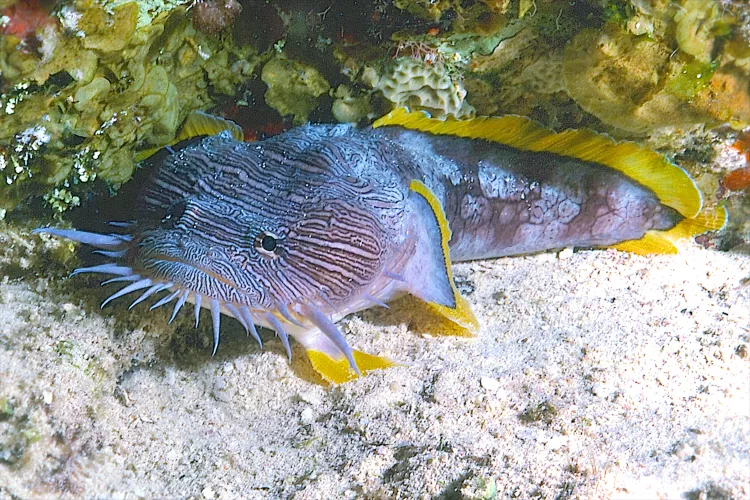
Photographing toadfish
Dive guides sometimes use commercial lures resembling squid to entice them out. Recently, some divers have been able to tempt toadfish out of their dens or caves by offering free meals of freshly speared lionfish. On occasion, I have been able to draw them out by mimicking the grunting sounds that they make.
If you are able to get a toadfish out in the open, move very slowly so you will not scare them. I like to take a test shot before I start looking for them, so that I will be pretty confident of my camera settings before approaching the toadfish. I like to shoot on manual settings, so I will usually do this for any type of shot of a possibly skittish subject.
Divers who want to find splendid toadfish to photograph, video or just observe for a while should talk to their guide before the dive, to get the guide to help find them. Toadfish can usually be found on many of the shallow reefs in Cozumel, including Paradise, Yucab and San Francisco Reefs. They are most often found on the western sides of these reefs.
Use the current to push you along as you listen for the tell-tale croaks or grunts they emit. Once you hear them and know they are present, get close to the sandy bottom, swim slowly and peer under ledges to look for the fish. Stay a foot or two from the sand, maintaining neutral buoyancy, and most importantly, slow down.
I like to use a reef stick to hold my position and examine an area more closely. The reef sticks also can be used as portable tripods. If you find a subject sitting on its doorstep, concentrate on getting a good image or two of the toadfish perched at the front of its cave, before you start thinking about ways of trying to entice it to come out in the open. Your guide may be able to coax one out, but remember that they are usually not too enthusiastic about leaving the safety of their dens.
At night, they can occasionally be found hunting out in the open. Since the fish is a nocturnal hunter, night dives improve your chances. Look for toadfish prowling the reef in search of small fishes, snails and polychaete worms. Remember to take your time on your dive, and enjoy the experience. The splendid toadfish is definitely one of my favorite fish to photograph in Cozumel. It is always a challenge to improve upon your previous shots.

